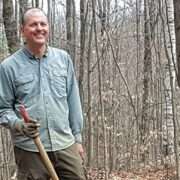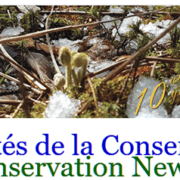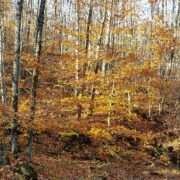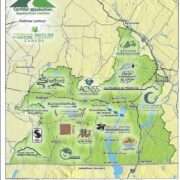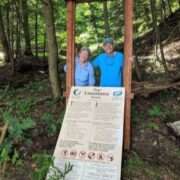
The Wilcox family,1955 on Lake Massawippi. Brandy (the dog), Bart, Gordon and Tom. Dr. Bud Wilcox on water skis. Who took the picture? Libby Wilson Wilcox sitting on the bow. The Wilcox camp in the background.
Tom Wilcox is a founding trustee of the Massawippi Foundation and the Massawippi Conservation Trust.
Tom is not new to Lake Massawippi, in fact he is a fifth generation American who is part of the long tradition of Americans who have been coming to Canada to escape the heat of the big city and enjoy life at the lake. His grandfather bought land 120 years ago and his father built the camp after the end of World War two.
When asked for his most memorable moment during his tenure on the board, Tom, who overflows with enthusiasm and love for the area, couldn’t stop at just one or two examples.
Peak memorable moments include:
The recognition of the Foundation and the Trust as legal entities.
- Around 2010, Tom and a small group of individuals, sprang into action after noticing that a large tract of land on the mountain had been acquired for development. These neophytes decided that they needed to create a legal entity to preserve the pristine forest and ecologically sensitive watershed.
The acquisition of Louise Ransom’s property.
- Tom was a neighbour of Louise Ransom (February 2021 article). He spoke to her for years about conservation, trying to get her to safeguard her land. At first he tried to get it under the protection of the Nature Conservancy of Canada but the piece was too small for them to consider. A small but significant parcel of land which Tom calls an anchor, pivotal to the conservation of the watershed of the lake.
The Challenge Grant to build the working capital of $ 100,000.
- For every $2 raised a small group of donors were prepared to give $1 towards the goal. The money was needed to operate, buy land, pay taxes and legal fees etc. Tom, as President of the Baltimore Community Foundation, lent his expertise to the group. They were successful not only because of their personal passion but because donors recognised the need to protect and preserve the land for the community and future generations.The dedication of the Massawippi trail at the top of Côte du Piémont.
The dedication event was the shining jewel in the crown, commemorating all of the fundamental beliefs of the founding members and the donors.
- First Nation, English, French, local residents, politicians, people of all stripes came together to celebrate the opening of the trails which gave the general public access to what was once private property. It was a recognition of the conservation values that the Wardman family and others like Louise Ransom. Métis Paul Carignan and his wife Sylvia Bertolini sang an Anishnabe Sun Song. Their presence commemorated the original Abenaki people whose territory included this land. The land was recognized for its value and returned to the public as a protected space.
Tom spoke about the original idea of creating a legacy to secure what everyone loved most, the green space and fresh water of Lake Massawippi. Establishing an entity to ensure a clean, quiet, safe space. The group had a desire to work with the water protection association, Bleu Massawippi and the local communities to protect and preserve, to ensure the health and prosperity of the region.
From the citizen of Baltimore who settled in Baltimore Bay (on the west side of the lake) comes a heartfelt message for the community. The trails are the democratisation of the conservation acquisitions. The conservation efforts are not about creating green play grounds for the rich but rather something for the public. The idea is that private property is made available for public use. A concept which is more popular in the United States.
According to Tom, everyone who has grown up on the lake lived in fear of roads (a.k.a. development) appearing on the mountain. When he was a little boy, there were no roads to Blueberry point or northwards. Reaching their cottage was and still is by water access only. Properties would be worth ten times more if there were road access. The entire landscape would be different. And that is not why his grandfather bought the land 120 years ago.
Tom and his wife hope that the Wilcox camp will stay in the family and perpetuate the now six generations of family tradition. The surrounding property is protected by a conservation servitude. Along with the deep respect from the long family tradition comes the idea that through the Conservation Trust the area will be preserved for future generations and the public can have responsible access to the land. People cannot build more cottages on the land however the property can be sustained complimentary activities can be created.
To end the interview Tom said, “ General Motors is going to be carbon neutral by 2035 and all electric by 2045 so he would like to think that boats on Lake Massawippi could be all electric and quiet, a model, an eco-tourism center being one with nature like the Abenakis who lived here before we invaded. They were one with nature.”
Can we be?


